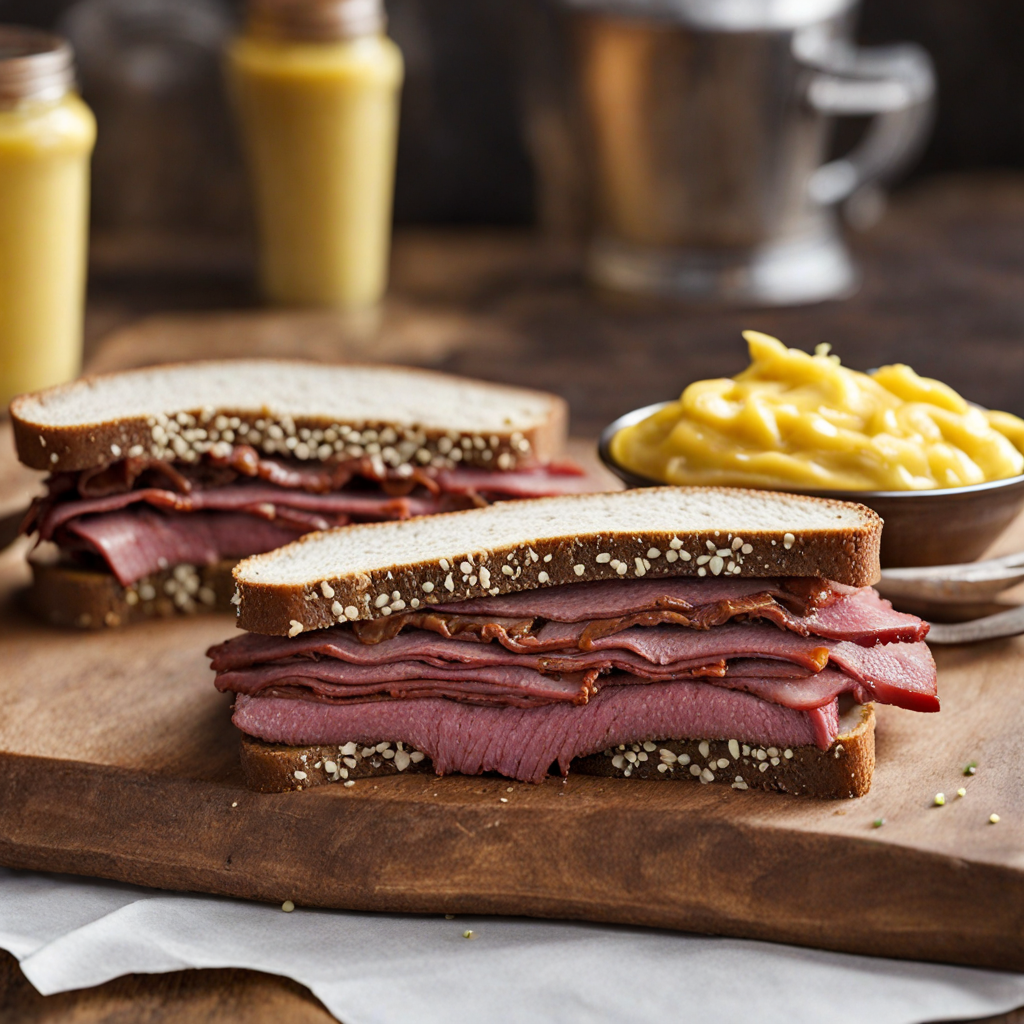Hot Dog
Hot dogs are a quintessential American street food that embody the spirit of casual dining and outdoor gatherings. Typically made from finely ground meat, which can include beef, pork, or poultry, these sausages are seasoned with a blend of spices and then encased in a soft, edible casing. The result is a juicy, flavorful link that’s both satisfying and portable, making it the perfect option for picnics, barbecues, and sporting events. Served in a soft, sliced bun, hot dogs are incredibly versatile, allowing for a wide array of toppings and condiments that can transform each bite into a unique experience. The beauty of hot dogs lies in their adaptability to different flavor profiles. Classic toppings include mustard, ketchup, and relish, but the creativity doesn't stop there. Regional variations abound, such as the Chicago-style hot dog, which features a bright green pickle relish, chopped onions, tomato slices, pickled sport peppers, and a dash of celery salt, all piled high on a poppy seed bun. Alternatively, a New York-style hot dog might be topped with sauerkraut and spicy brown mustard, showcasing the diverse culinary influences found in the United States. For those seeking a twist, gourmet hot dogs can be adorned with everything from avocado to kimchi, elevating this humble dish to new heights. Hot dogs are more than just simple street food; they represent a slice of American culture and tradition. Often grilled or steamed, they develop a delightful char or steaminess that enhances their flavor and texture. Enjoyed at baseball games, county fairs, or backyard barbecues, hot dogs evoke a sense of nostalgia and community. With a rich history that dates back to the late 19th century, they have become a beloved symbol of American cuisine, inviting food lovers to explore an endless array of toppings and pairings, ensuring that every bite is a delicious adventure.
How It Became This Dish
The History of the Hot Dog: A Culinary Journey The hot dog, a quintessential symbol of American cuisine, boasts a history that traverses continents, cultures, and centuries. Its evolution from simple meat sausages to a beloved street food staple encapsulates the complexities of immigration, urbanization, and cultural exchange in the United States. #### Origins: The Sausage's Long History The story of the hot dog begins long before it graced the streets of American cities. Sausages, in various forms, have been a part of human culinary traditions for millennia. The ancient Greeks and Romans enjoyed sausages made from various meats, often seasoned with herbs and spices. However, it was in Germany that the modern sausage, particularly the "frankfurter" (named after Frankfurt), and the "wiener" (named after Vienna), began to take shape. As German immigrants began to arrive in the United States in the 19th century, they brought with them their culinary traditions, including these flavorful sausages. By the 1850s, butcher shops in cities like New York and Chicago began producing their versions of these sausages, often served in a loaf of bread or a bun, laying the groundwork for what would become the American hot dog. #### The Birth of the Hot Dog The term "hot dog" itself has a rather whimsical origin, with various theories surrounding its inception. One popular story attributes the name to a cartoonist named Tad Dorgan, who, in the late 1800s, attended a baseball game in New York City where vendors were selling these sausages in rolls. Allegedly, he drew a cartoon depicting the sausages and, unsure of the spelling for "dachshund sausage," he simply labeled it "hot dog." While this story is likely apocryphal, it reflects the playful nature of American culture and the hot dog’s emerging identity. In the early 20th century, hot dogs began to gain popularity at outdoor events, particularly baseball games. They were affordable, easy to eat, and could be enjoyed while standing or walking, making them the perfect snack for the burgeoning urban lifestyle. Vendors began to sell them from carts, and soon, hot dogs became synonymous with American sporting events. #### Cultural Significance The hot dog quickly established itself not only as a popular food item but as a cultural icon. It became a symbol of American identity, embodying the spirit of convenience, mobility, and casual dining. The hot dog is often associated with summer barbecues, Fourth of July celebrations, and street fairs, transcending class and cultural boundaries. In 1939, the hot dog took on a new level of significance when it was served at a picnic for President Franklin D. Roosevelt at Hyde Park, New York, during a visit from the King and Queen of England. This event served to further entrench the hot dog in the fabric of American life, elevating it from mere street food to a symbol of national pride. #### The Hot Dog's Evolution As the 20th century progressed, the hot dog continued to evolve. During World War II, rationing led to a surge in the popularity of processed foods, including hot dogs. The introduction of mass production techniques allowed for cheaper, more accessible hot dogs, and brands like Oscar Mayer and Nathan’s Famous began to dominate the market. Nathan’s Famous, in particular, became a landmark in hot dog history. Founded in 1916 by Nathan Handwerker, a Polish immigrant, the Coney Island eatery became famous for its delicious hot dogs and has since hosted the annual Nathan's Hot Dog Eating Contest each Fourth of July. This event, which started in 1978, has turned into a spectacle of competitive eating, drawing participants and spectators from around the world, further cementing the hot dog’s place in American popular culture. #### Regional Variations The hot dog is not a one-size-fits-all food; it has adapted to regional tastes and preferences across the United States. Each region has its own unique take on this classic dish. 1. Chicago Style: Chicago hot dogs are famously "dragged through the garden," meaning they are topped with an array of fresh vegetables, including onions, tomatoes, and pickles, along with a dash of yellow mustard and sport peppers—all served on a poppy seed bun. Ketchup is a controversial no-go in this city. 2. New York Style: New Yorkers prefer their hot dogs with a simple topping of mustard and sauerkraut or onions in a tomato-based sauce, reflecting the city’s rich immigrant history. 3. Coney Island Style: Originating from the Coney Island area, these hot dogs are typically topped with a meat sauce, onions, and mustard, creating a flavor-packed experience. 4. Texas Style: In Texas, hot dogs often take on a barbecue twist, topped with brisket, jalapeños, and barbecue sauce, showcasing the state’s love for smoky, hearty flavors. These regional variations not only highlight the adaptability of the hot dog but also reflect the diverse culinary landscape of the United States, where food serves as a means of cultural expression. #### Contemporary Trends and Health Considerations In recent years, the hot dog has faced challenges related to health and nutrition, as consumers have become more health-conscious. The rise of gourmet hot dogs featuring high-quality meats, organic ingredients, and unique toppings has emerged in response to these concerns. Food trucks and upscale eateries now offer variations like vegan hot dogs, artisanal buns, and globally-inspired toppings, appealing to a broader audience. Despite these changes, the hot dog maintains its status as a cherished American food. From backyard barbecues to sports stadiums, it continues to be a beloved choice for many. As the world becomes increasingly interconnected, the hot dog stands as a symbol of the American experience—adaptable, inclusive, and ever-evolving. #### Conclusion The hot dog’s journey from humble sausage to an iconic American food reflects broader themes of immigration, cultural exchange, and the evolution of culinary traditions. It is a dish that has not only satisfied hunger but has also served as a vehicle for social interaction and cultural expression. Whether enjoyed at a summer cookout, a bustling street fair, or a major sporting event, the hot dog remains a testament to the vibrant tapestry of American life, celebrating the fusion of flavors and traditions that define the nation. As we relish these tasty treats, we partake in a delicious history that continues to unfold, one bite at a time.
You may like
Discover local flavors from United States







